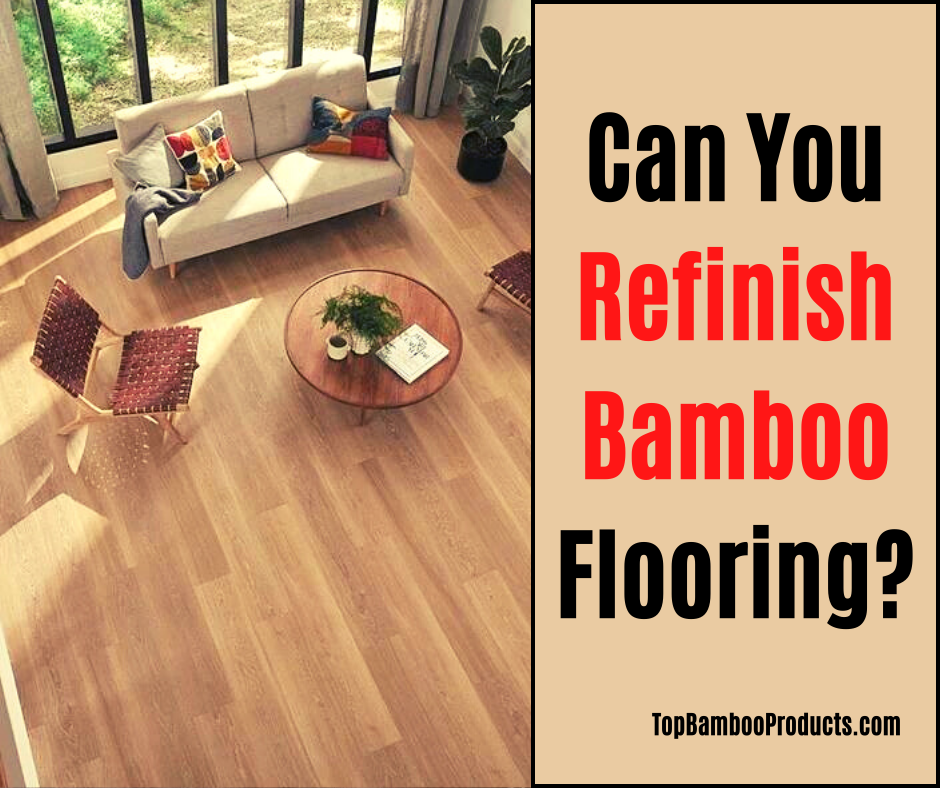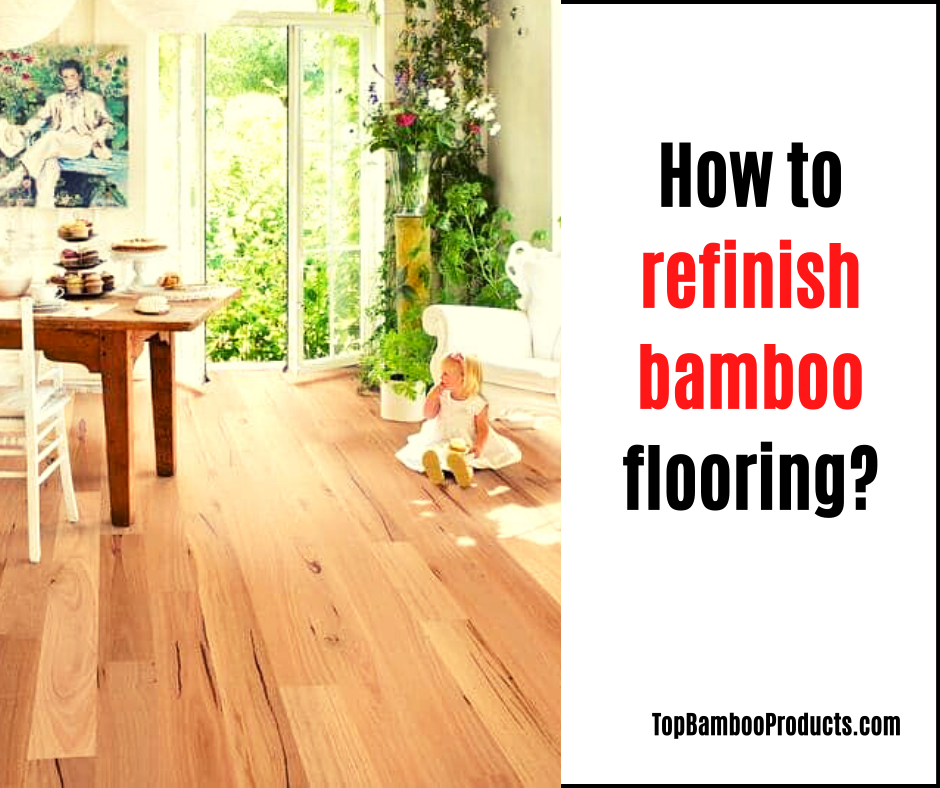Can You Refinish Bamboo Flooring?

0Shares
Can you refinish bamboo flooring? If so, how do you get started, and what are the supplies you need to complete the project? This post has all the answers and more on how to complete the scratched/dented bamboo flooring you might have on your hands.
Read More:
- Plants that Bear Resemblance, to the Elegant Bamboos; Similarities, in Appearance
- How To Water Bamboo In Pots? Making Your Potted Plant Thrive
- Mastering the Best Time to Plant Bamboo for an Optimal Growth
- Sustainable Construction: Benefits of Bamboo As Building Material
- What Are The Different Ways To Use Bamboo In Interior Design?
Can you refinish bamboo flooring?

Yes. You can refinish bamboo flooring – whether the floor is an engineered strand or solid. Hiring a professional to refinish the bamboo floors is most people’s preferred method of action. In this case, they will take the tools and the steps for refinishing the floor. However, if you are a DIYer and have plans to refinish bamboo flooring, below are the steps and the required tools. Read Here: How to Get Scratches Out of Bamboo Floors [Guide]
Tools required to refinish a bamboo floor
- Low VOC wood stain
- Sanding machine
- Putty/fillers
- Stain sealant/sealer
- Paint brushes or rollers
- Sandpapers – 80/100 and 150/180 grit
- Safety gloves, masks, and glasses
- Rags/drop clothes
- Mineral spirits
- Painters tape
How to refinish a bamboo floor

Below are the basic steps to refinish a bamboo floor.
Note: Before you start the refinishing process, make sure you wear the appropriate protective gear.
Step 1 – Clean and prep
Remove all furniture in the room and remove the trim and baseboards, if any. Tape up the room, including air vents and doorways, to prevent the dust from escaping and vacuum it thoroughly.
Step 2 – Smooth the surface
Smoothing the floor is a critical step in making sure the refinished floor looks perfect, and this is where sanding comes in. 80 to 100-grit sandpaper usually works best for removing the top layer of the floor.
Engineered bamboo floors do not require a lot of pressure, but a solid strand one might require more than one pass with the sander. The final round of sanding works best with 150 to 180-grit sandpaper which should smoothen all types of small to medium scratches. Read Here: How To Clean Engineered Bamboo Floors?
Step 3 – Vacuum the dust and debris
Use a broom to clear the larger debris on the floor and thoroughly vacuum it. Sanding the floor often leaves a lot of dust in the crevices of the floor, which can compromise the performance of the stain.
Step 4 – Fill and prep
At this stage, if you see any visible damage to the bamboo floor, use a putty/wood filler to refill and make the area smooth. Allow the filler to dry completely. Use the rags and mineral spirits to wipe down the entire floor and wait for some minutes before proceeding to stain.
Step 5 – Staining
Start staining with the new paint brushes following the manufacturer’s directions. Refinishing bamboo floors with good results requires two layers of staining but allows the first coat to dry before the second. Patch staining to test the final look on the floor is also a good idea but not mandatory.
Step 6 – Finishing touches
After the stain has dried for a few hours, it is time to add the finishing touches. Apply the stain sealant/sealer with a paintbrush or a roller – follow the manufacturer’s instructions. Two coats of the stain sealer are also recommended, but remember to allow the first coat to dry before the second.
Application of the stain sealer during the refinishing process of the bamboo floor is paramount as it protects the wood. Some bamboo stain sealants also protect the wood from UV rays, which can cause discoloration and fading. Allow your newly refinished bamboo floor to dry for a few hours before you walk on them. Read Here: Can you put a bamboo mat in the shower?
Read More:
- Plants that Bear Resemblance, to the Elegant Bamboos; Similarities, in Appearance
- How To Water Bamboo In Pots? Making Your Potted Plant Thrive
- Mastering the Best Time to Plant Bamboo for an Optimal Growth
- Sustainable Construction: Benefits of Bamboo As Building Material
- What Are The Different Ways To Use Bamboo In Interior Design?
How often can you refinish bamboo flooring?

Most people assume that strand-woven bamboo flooring is not possible because it is extremely hardy. However, all types of bamboo flooring can be refinished; the only issue is the number of times the floors can undergo refinishing. The difference in the tolerance of bamboo floors for refinishing is because of their structure.
Engineered bamboo floors
Engineered bamboo flooring that is 3-4mm thick can undergo the refinishing process up to four times. Engineered bamboo floors usually have up to two to three layers of construction materials, including – a thick layer of bamboo at the top and a rigid SPC/HDF layer underneath.
Some companies also use multiply-eucalyptus cores underneath the bamboo layer. However, engineered bamboo floors do not require regular refinishing because of their robust construction. These bamboo floors also have aluminum oxide, making them very resilient to scratches and have great durability.
Solid-strand woven bamboo floors
Solid-strand woven bamboo floors can only be sanded about two times. Bamboo forms only the top layer in this type of flooring structure with solid strands. Since refinishing usually involves sanding and staining, the floor can only withstand so much aggressiveness without breaking down.
Carbonized bamboo floors
Carbonized bamboo floors are among the easiest to refinish because they are softer, which works in its favor because they are prone to scratches and dents. This type of bamboo flooring has a darker appearance because of the treatment and can be refinished two to three times. Refinishing carbonized bamboo floors does not lighten their dark appearance, so you don’t have to worry about the colors fading.
Non-carbonized bamboo floors
These are also known as natural bamboo floors and resist dents and scratches, which is a great advantage. In addition, their natural light color also camouflages the damages very well. You can do so if you’re curious about refinishing a natural bamboo floor. But these bamboo floors do not require touching up frequently after installing them.
Read More:
- Plants that Bear Resemblance, to the Elegant Bamboos; Similarities, in Appearance
- How To Water Bamboo In Pots? Making Your Potted Plant Thrive
- Mastering the Best Time to Plant Bamboo for an Optimal Growth
- Sustainable Construction: Benefits of Bamboo As Building Material
- What Are The Different Ways To Use Bamboo In Interior Design?
Wrapping up
There you have it! All the answers to the question, can you refinish bamboo flooring? Refinishing bamboo flooring as DIY is quite possible with the steps shown above. Depending on the type of bamboo floor you have, refinishing them is quite feasible.
However, staining a solid strand woven bamboo floor can be tricky, so it’s best left to professionals, but the rest are pretty to work with – provided you have all the tools and a little patience. As a parting shot, refinishing bamboo flooring can be messy, time-consuming, and expensive if you take into account all the tools you have to purchase. So consider hiring a professional for refinishing your bamboo floors.
0Shares

